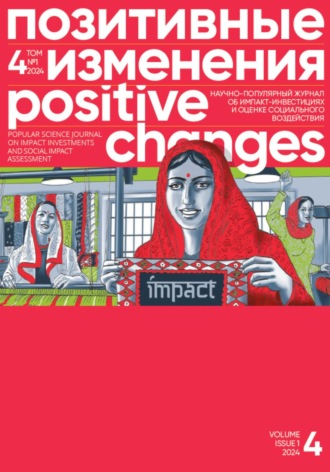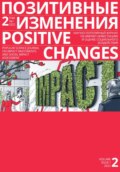
Редакция журнала «Позитивные изменения»
Позитивные изменения. Том 4, №1 (2024). Positive changes. Volume 4, Issue 1 (2024)
• 54 % of teams experienced a CCI increase above 20 %. Among them, 6 teams demonstrated a significant growth – over 30 %;
• The increase in publication outreach amounted to 6 %. Overall, this is a challenging parameter to develop during the media accelerator training, as the fruits of labor will only be visible after 3–6 months. However, significant outreach growth was observed in cities like Desnogorsk, Tryokhgorny, Polyarnye Zori, and Udomlya.
From the start of the “Media Station” educational program, as the first index measurement showed, leaders emerged: Sarov (Nizhny Novgorod Region), Zarechny (Penza Region), Desnogorsk (Smolensk Region), and Zelenogorsk (Krasnoyarsk Territory). By December 2023, Dimitrovgrad (Ulyanovsk Region) and Ozersk (Chelyabinsk Region) had joined them, jumping up 7 and 13 positions respectively.
The teams’ main advantage came from their prepared base: the level of knowledge and skills was quite high initially. However, it’s important to note that even teams with a low background managed to climb the rankings and closed up on the leaders by developing their skills and acquiring knowledge.
Further enhancement of the ICS methodology can be achieved by:
• Expanding the list of second-level parameters to be measured;
• Finding other measurement methods.
The developers aim to introduce the index to the expert community and other major industrial corporations, potentially at venues like the Public Chamber of the Russian Federation. They plan to establish the practice of measuring the index in nuclear cities as a regular activity. The subsequent assessment is scheduled within the new season of the Media Accelerator in spring 2024.
The methodology of the index will undergo refinement based on expert recommendations and the practical application of the tool. A significant part of this refinement involves automating data collection to ensure measurements can be done more rapidly, cost-effectively, and transparently. The development methodology of the Communication Competency Index may serve in constructing other index-based (comprehensive) indicators for evaluating the effectiveness of processes involved in forming and training (educating) project teams. It is noteworthy that the CCI embodies all the crucial characteristics of similar methodologies.
The authors express their gratitude to Irina Kalistratova, Roman Skudnyakov, Tuyaara Kychkina, Mikhail Chirkov, Anna Romanicheva, and Anastasia Filimonova for their assistance in preparing the material.
На пути к единой форме: нас ждет эра импакт-предпринимательства?
Валерия Завгородняя, Ирина Лактюшина
DDOI 10.55140/2782-5817-2024-4-1-67-73

С появлением и развитием гибридных некоммерческих организаций и социального предпринимательства и все большим вниманием компаний к социальному воздействию, границы между ними начинают стираться – такой тренд замечают эксперты.
Этот процесс неизбежно ведет к эволюции в общую форму – импакт-предпринимательству, которое объединяет в себе лучшие аспекты социальных проектов и бизнеса.
Что говорит о начале этого движения, какие признаки мы можем наблюдать уже сейчас, и что ждет нас в будущем, если этот этап развития придет к своему логическому завершению?

Валерия Завгородняя
Кандидат экономических наук, генеральный директор «Бюро импакт-решений»

Ирина Лактюшина
Руководитель проектов «Бюро импакт-решений»
НКО И СОЦИАЛЬНЫЕ ПРЕДПРИЯТИЯ: ВСЕ МЕНЬШЕ РАЗЛИЧИЙ
Социальные и экологические проблемы, с которыми сталкивается современное общество, становятся все более сложными и многоуровневыми. Бедность, неравенство, изменение климата – все это требует инновационных и комплексных подходов и трансформации сектора, ведь часто самые эффективные решения для этого находятся в смежной области или появляются благодаря объединению разных стейкхолдеров. И мы уже сейчас можем наблюдать первые признаки движения к изменению привычного расклада вещей.
Во-первых, происходит рост и профессионализация некоммерческого сектора. По данным Министерства экономического развития, в 2022 году в России появились более 10 тысяч новых некоммерческих организаций, в 2021 – почти 10,5 тысяч. Всего по состоянию на конец 2022 года в нашей стране работают 210 тысяч некоммерческих организаций, из них социально ориентированных – 46 тысяч[65]. Одновременно с этим сфера социального предпринимательства показывает значительный рост: в 2023 году, по данным Минэкономразвития, количество социальных предприятий в Едином реестре субъектов малого и среднего предпринимательства увеличилось почти на 3 тысячи и сейчас приближается к 11 тысячам[66].
При этом важно отметить, что далеко не все организации, которые работают как социальные предприятия и по формальным признакам ими являются, подают заявки на включение в реестр, поэтому фактическое число СП в России еще больше. Среди множества подходов к определению социального предпринимательства мы ориентируемся на критерии Фонда региональных социальных программ «Наше будущее»[67]. Эксперты фонда определяют СП как новаторскую предпринимательскую деятельность, направленную на решение или смягчение социальных проблем в обществе. К критериям социального предпринимательства они относят: социальное воздействие, финансовую устойчивость, предпринимательский подход, инновационность, самоокупаемость и тиражируемость. И далее мы будем говорить о СП в широком смысле как о субъектах малого и среднего предпринимательства, которые используют предпринимательский подход для решения социальных проблем. Мы не берем во внимание тот факт, зарегистрированы ли они в качестве бизнеса социального характера в реестре малого и среднего предпринимательства[68] или нет.
Точное количество СП невозможно определить еще потому, что мы, к сожалению, не можем знать, какой процент организаций из почти 50 тысяч социально ориентированных НКО является гибридными и имеют второе юридическое лицо в виде социального предприятия. Однако, учитывая увеличившееся количество программ и курсов для НКО по монетизации услуг и уже многолетнюю тенденцию на «слезание с грантовой иглы», можно предположить, что уже 20 или 30 % некоммерческих организаций являются в том числе и социальными предприятиями.
В некоммерческие организации все чаще приходят специалисты из бизнес-сферы. По данным исследования Агентства социальной информации и группы «Циркон», 41 % руководителей и 43 % сотрудников до этого работали в коммерческом секторе. В госучреждениях в сфере образования, культуры, здравоохранения – 34 % руководителей и 31 % сотрудников[69]. Многие из них, если судить по общему вектору развития НКО и тенденции на монетизацию услуг, приносят с собой инструменты предпринимательства и внедряют их в работу организаций.
Границы между НКО и социальными предпринимателями становятся все менее явными. Например, довольно непросто сразу определить организационно-правовую форму организации по ее описанию. Попробуйте угадать, в каком случае идет речь об НКО, а в каком – о социальном бизнесе.
Первая организация: центр инклюзивных проектов и социальной интеграции детей с особыми потребностями, в котором проходят инклюзивные платные и бесплатные занятия с дефектологом, арт-терапевтом, специалистом по адаптивной физкультуре, кулинарные занятия, а также по работе с керамикой, деревом и другими материалами.
Вторая: центр коррекции для детей с речевыми и психоречевыми нарушениями, в том числе с расстройством аутистического спектра. Специалисты этого центра проводят индивидуальные и групповые занятия.
Обе организации работают как с детьми с особенностями развития, так и с нормотипичными детьми, в обоих случаях есть как платные, так и бесплатные занятия. Но в первом случае речь идет об автономной некоммерческой организации Центр инклюзивных проектов и социальной интеграции детей и взрослых с особыми потребностями «Какая разница!», а во втором – о центре развития речи Logolab, который работает как ИП и является примером социального предприятия.
Безусловно, между НКО и социальными предпринимателями на законодательном уровне все еще сохраняются четкие границы, но экономическая ситуация и законы развития работают так, что если какие-то подходы и инструменты хорошо работают в одной сфере, то и другой сектор начинает их активно использовать. Именно это мы и наблюдаем прямо сейчас.
Границы между НКО и СП становятся все менее явными. Теперь непросто сразу определить организационно-правовую форму компании по ее описанию.
СОЦИАЛЬНЫЕ ПРЕДПРИНИМАТЕЛИ И/ИЛИ СОЦИАЛЬНО ОТВЕТСТВЕННЫЙ БИЗНЕС?
Количество крупных компаний в России, которые реализуют программы социальной ответственности, по данным ВЭБ.РФ, тоже возросло в два раза в 2022 году – с 2,9 в 2021 до 5,5 компаний в городе[70]. При этом, согласно опросу ВЦИОМ, внедрение принципов КСО в корпоративное управление российских компаний попадает в фокус внимания граждан. Если во второй половине 2000-х в среднем около четверти россиян могли назвать российский бизнес социально ответственным, то к 2023 году эта доля выросла до 44 %[71]. И здесь важно отметить, что эти корпорации постепенно перераспределяют свои бюджеты и программы в сфере КСО с адресной благотворительности на системную работу в сфере решения социальных проблем.
Например, в отчете об устойчивом развитии Яндекса указано, что в основе его благотворительной деятельности лежит системный подход и собственные технологии. В 2022 году компания зарезервировала почти 479 млн рублей «на развитие системной благотворительности через свои сервисы и технологии». На деятельность своего благотворительного фонда «Помощь рядом» компания выделила 113,2 млн рублей.
Группы компаний «Аэрофлот» и «Росатом» в свою очередь тоже сосредоточились на системной помощи и устойчивом развитии. «Аэрофлот» в 2022 году впервые разработал и утвердил Политику в области устойчивого развития, а в государственной корпорации «Росатом» для повышения качества социальных проектов и расширения форматов волонтерской помощи начал работу Университет корпоративной социальной ответственности.
Конечно, разница между небольшим социальным предприятием и огромной корпорацией слишком велика, чтобы поставить между ними знак равенства. Куда больше сходства наблюдается между СП и малым или средним бизнесом, который также все более активно включается в социальную повестку, иногда даже не артикулируя это для себя и внешней аудитории и не выделяя эту деятельность в отдельное направление.
Как показало исследование Лиги зеленых брендов, компании IFORS Research и «Опоры России», 73 % компаний отметили, что сохраняют рабочие места во время декретного отпуска, 70 % внедряют бережливое потребление или производство, 54 % создают индивидуальные планы развития и обучения сотрудников, а 46 % компенсируют медицинские расходы, траты на здоровье и спорт для сотрудников и их семей. В будущем 30 % опрошенных планируют пойти дальше и сокращать экологический ущерб, заниматься посадкой деревьев, очисткой территорий и водоемов, внедрять раздельный сбор мусора и оптимизировать логистические маршруты. Инвестировать в социальные и благотворительные проекты, заниматься волонтерством и менторством собираются 29 % компаний[72].
У владельцев небольших компаний меньше ресурсов, чем у их более крупных конкурентов, но и они тоже заинтересованы в добавлении импакта в свою деятельность, поскольку наблюдают изменение рыночной среды, портрета и ценностей потребителя. Так, по данным исследования международного рекламного агентства Ogilvy, 40 % опрошенных представителей поколения Z бойкотируют неустойчивые бренды, у которых нет четкого позиционирования по значимым социальным, экологическим или политическим вопросам, а 63 % с большей вероятностью купят у брендов, которые выстраивают свое позиционирование вокруг благотворительной, экологической или социально значимой миссии[73].
Эта тенденция касается не только представителей молодого поколения. Как отмечают специалисты OKKAM GROUP, инфляция и повышение стоимости жизни в целом переводят потребительское восприятие ответственного потребления в практическую плоскость, связанную в том числе с персональной выгодой. Долговечность вещей, энергоэффективность, долгосрочная выгода и шеринг становятся частью ключевых характеристик продукта.
Желание малого и среднего бизнеса добавить импакт в свою деятельность также обусловлено стремлением попасть в цепочку поставок крупных корпораций, которые с большей вероятностью выберут компании, внедряющие принципы социальной ответственности. Кроме того, в борьбе за клиентов компании все больше обращают внимание на те аудитории, которые раньше не попадали в поле их зрения. Среди них, например, люди с инвалидностью – это тоже большой платежеспособный сегмент. Адаптируя и создавая для них продукты и сервисы, бизнес может значительно увеличить клиентскую базу, что положительно скажется на бизнес-показателях, и одновременно усилить свой импакт.
В связи с этим мы все чаще видим интеграцию социальных целей в бизнес-модель малого и среднего бизнеса, часто даже без явного выражения своей социальной позиции. Небольшие типографии печатают флаеры и афиши для благотворительных фондов, IT-компании pro bono предоставляют свои услуги для активистов, парикмахерские стригут бездомных людей, маленькие кинотеатры проводят кинопоказы для детей с ОВЗ и детей из малообеспеченных семей, кофейни «подвешивают» кофе для нуждающихся и привлекают к работе людей с инвалидностью. Так разница между социальными предпринимателями и социально ответственным бизнесом постепенно размывается.
ЕДИНАЯ ФОРМА: ИМПАКТ-ПРЕДПРИНИМАТЕЛЬСТВО
Если наша гипотеза верна, то российское общество движется в сторону объединения НКО, СП и социально ответственного малого и среднего бизнеса в единую форму импакт-предпринимательства.
Импакт-предпринимательство объединяет в себе их лучшие аспекты. Важно, что это не строгая юридическая форма, а скорее качественное определение основной идеи организации – решение социальных проблем через инновации и устойчивые и эффективные бизнес-модели.
Слияние различных типов организаций позволяет более эффективно использовать ресурсы и знания из различных сфер, стимулирует инновации и позволяет экспериментировать с новыми технологиями, моделями бизнеса и финансирования. Кроме того, это способствует развитию новых источников финансирования: если грани размываются, то меры поддержки начинают включать в себя разные организации. Стоит отметить, что уже сейчас государственные и частные грантовые операторы проводят свои конкурсы как для НКО, так и для коммерческих организаций, ИП, физических лиц, муниципальных учреждений. Среди примеров – и федеральный Президентский фонд культурных инициатив, и локальный конкурс «Социальный лидер Усолья-Сибирского» государственной корпорации «Росатом».
Единая форма импакт-предпринимательства может быть более привлекательной для инвесторов, поскольку она объединяет в себе лучшие практики как коммерческого бизнеса, так и некоммерческих организаций. Таким образом, импакт-предприниматели смогут получать не только прибыль, но и пожертвования, гранты и субсидии, привлекать инвестиции и другие формы финансирования, направленные на достижение социальных целей.
Еще один плюс такой унификации – это, конечно, увеличение импакта. Собранные воедино лучшие практики решения социальных проблем, доступ к разным источникам финансирования, стремление к инновациям будут способствовать расширению положительного влияния на общество.
Если же говорить о минусах, то можно выделить вероятность потери уникальности и идентичности и риск ухода от миссии и ценностей. Это может привести к размыванию фокуса и направления деятельности, что, в свою очередь, негативно скажется на достижении социальных целей. Кроме того, существует вероятность снижения прозрачности и доверия, поскольку процесс монетизации услуг и деятельности организаций может вызвать сомнения в их намерениях. Однако потенциально негативные последствия можно нивелировать: для этого необходимо активно применять и популяризировать принципы прозрачности, а также использовать теорию изменений[74] организации в качестве ориентира для поддержания миссии и целей.
ЧТО ДАЛЬШЕ?
Стирание границ между гибридными НКО, социально ответственным бизнесом и социальными предпринимателями – это естественный шаг в эволюции социальных инициатив и экономической активности в целом. Импакт-предпринимательство представляет собой новую форму, которая интегрирует лучшие практики этих сфер и стремится к реальному, масштабному и стойкому изменению в обществе.
Это не просто тренд, а реальное движение к более созидательному и ответственному обществу, в котором для достижения положительных изменений используются самые эффективные инструменты работы и модели финансирования. НКО, СП и бизнесу больше не придется подстраиваться под огромное количество организаций, которые принимают решения и регулируют их деятельность и меры поддержки. Если правила игры понятны и едины для всех, жить и работать все-таки проще.
On the Path to a Unified Form: Are We Entering the Era of Impact Entrepreneurship?
Valeria Zavgorodnyaya, Irina Laktyushina
DDOI 10.55140/2782-5817-2024-4-1-67-73

With the emergence and development of hybrid non-governmental organizations and social entrepreneurship, coupled with companies' growing emphasis on social impact, the boundaries between them are increasingly blurring – a trend noted by experts. This process inevitably leads to an evolution towards a shared form – impact entrepreneurship, which merges the best aspects of social projects with business. What signifies the start of this movement, what signs are presently observable, and what can we expect in the future if this developmental stage reaches its logical conclusion?

Valeria Zavgorodnyaya
PhD in Economics, General Director, Impact Solutions Bureau

Irina Laktyushina
Project Manager, Impact Solutions Bureau
NGOS AND SOCIAL ENTERPRISES: DIMINISHING DISTINCTIONS
The social and environmental challenges contemporary society faces are becoming progressively more complex and layered. Poverty, inequality, and climate change require innovative and comprehensive approaches and sectoral transformation since often the most efficient solutions emerge from adjacent fields or collaborative efforts among various stakeholders. We can already discern the initial indications of a shift towards altering the established order.
Firstly, there is growth and professionalization within the non-profit sector. According to the Ministry of Economic Development, in 2022, Russia saw the establishment of over 10 thousand new non-governmental organizations, and nearly 10.5 thousand in 2021. As of the end of 2022, 210 thousand non-governmental organizations were operating in our country, with 46 thousand being socially oriented.[75] Concurrently, the realm of social entrepreneurship sees notable growth: in 2023, according to the Ministry of Economic Development, the number of social enterprises in the Unified Registry of Small and Medium-Sized Enterprises surged by nearly 3 thousand, nearing 11 thousand.[76]
It is crucial to acknowledge that not all entities functioning as social enterprises and meeting formal criteria submit applications for the registry, thus the factual count of social enterprises in Russia is considerably greater. Among the multitude of approaches to defining social entrepreneurship, we adhere to the criteria set forth by the Foundation for Regional Social Programs “Our Future”.[77] The Foundation’s experts define social entrepreneurship (SE) as innovative business activity directed towards solving or alleviating social problems in society. They include the following as criteria for social entrepreneurship: social impact, financial viability, entrepreneurial approach, innovation, self-sufficiency, and scalability. Moving forward, we will discuss SE in the broader context of small and medium-sized enterprises that apply an entrepreneurial method to address social issues. We disregard whether or not these entities are registered as social businesses in the Registry of Small and Medium-Sized Enterprises.[78]
The precise count of social enterprises (SEs) remains elusive because, regrettably, it is unclear what proportion of the nearly 50,000 socially oriented NGOs are hybrids and possess a secondary legal entity as a social enterprise. Nonetheless, with the increasing number of programs and initiatives for NGOs to monetize services and the pervasive trend of moving beyond grant dependency, it is plausible that already 20 to 30 % of NGOs also qualify as social enterprises.
Nonprofit organizations are increasingly regarded as attractive workplaces by business sector professionals. As identified by studies from the Social Information Agency and Zircon Group, 41 % of leaders and 43 % of staff members have backgrounds in the commercial sector. 34 % of senior managers and 31 % of staff[79] come from the domains of education, culture, and healthcare within public institutions. Many of these individuals, in line with the general trajectory of NGO development and the trend towards service monetization, integrate entrepreneurial tools into their organizational practices.
The distinctions between NGOs and social entrepreneurs are growing increasingly indistinct. For instance, it is often challenging to promptly ascertain an organization’s legal structure based on its description alone. Try to deduce whether we are discussing NGOs or social businesses based on the following descriptions.
The first organization is a center for inclusive projects and social integration of children with special needs, offering both paid and complimentary sessions with a defectologist, art therapist, specialist in adaptive physical education, as well as cooking classes, and workshops in ceramics, woodwork, and other materials.
The second organization is a center for the correction of speech and speech-related disorders in children, including those with autism spectrum disorders. The specialists at this center conduct both individual and group sessions.
Both organizations work with children who have developmental disorders as well as with neurotypical children, offering both paid and free classes in both cases. But in the first case, we are discussing the autonomous non-governmental organizations” “Center for Inclusive Projects and Social Integration of Children and Adults with Special Needs ‘What a Difference!’,” and in the second, we refer to the Logolab Speech Development Center, which operates as an individual intrapreneur and exemplifies a social enterprise.
Clearly, there are defined legal distinctions between NGOs and social entrepreneurs; however, economic circumstances and evolutionary laws dictate that when certain methodologies and instruments prove effective in one domain, they begin to be actively employed in another. That’s precisely the phenomenon we are observing at this moment.
The distinctions between NGOs and SE are growing indistinct. It is often challenging to ascertain an organization’s legal structure based on its description alone.
SOCIAL ENTREPRENEURS AND/OR SOCIALLY RESPONSIBLE BUSINESSES?
The count of sizeable Russian companies implementing social responsibility initiatives has, according to VEB.RF, doubled in 2022 – from 2.9 in 2021 to 5.5 companies in the city.[80] Concurrently, a VCIOM survey reveals that integrating CSR principles into the governance of Russian corporations is getting significant public attention. If in the second half of the 2000s, roughly a quarter of Russians recognized their domestic business as socially responsible, by 2023 this figure has increased to 44 %.[81] It is also worth noting that these corporations are gradually shifting their CSR investments from isolated charitable acts to a systematic approach in addressing societal challenges.
For example, Yandex’s sustainability report indicates that its philanthropic activities are founded on a systematic approach and use of its own technologies. In 2022, the company has set aside almost 479 million rubles for the development of systematic charity through its services and technologies. The company allocated 113.2 million rubles for the activities of its charitable foundation “Help is Near.”
The Aeroflot and Rosatom groups have likewise concentrated on systemic aid and sustainable development. In 2022, Aeroflot formulated and endorsed its Sustainability Policy, while the state corporation Rosatom initiated the Corporate Social Responsibility University to enhance the quality of social projects and broaden the scope of volunteerism.
Naturally, there is a considerable disparity between a modest social enterprise and a colossal corporation, rendering it inappropriate to compare them as equals. A closer resemblance is found between social enterprises and small or medium-sized enterprises, increasingly engaged in the social discourse, often without expressly recognizing or communicating it as a distinct avenue.
Research by the Green Brands League, IFORS Research, and Opora Rossii reveals that 73 % of companies maintain employment during parental leave, 70 % adopt resource-efficient practices, 54 % offer tailored development plans for staff, and 46 % compensate for medical and sporting expenses for their workforce and families. In the future, 30 % of those surveyed plan to go further in reducing environmental damage by engaging in tree planting, cleaning up territories and bodies of water, implementing separate waste collection, and optimizing logistic routes. 29 % of companies intend to invest in social and philanthropic endeavors, participate in volunteerism, and provide mentorship.[82]
Small business proprietors, despite fewer resources compared to their larger counterparts, also show an eagerness to incorporate impactful strategies into their business models in response to shifting market dynamics, consumer profiles, and values. According to Ogilvy’s research, 40 % of Generation Z respondents shun brands with unclear stances on significant social, environmental, or political matters, while 63 % are inclined to patronize brands that align their positioning with charitable, environmental, or socially impactful missions.[83]
This tendency is not exclusive to the younger generation. Specialists at OKKAM GROUP note that inflation and the overall rise in living costs are shifting consumer perspectives of responsible consumption into actionable strategies, including those yielding personal benefits. Product longevity, energy efficiency, long-term value, and sharing are increasingly becoming part of the core attributes of products.
Small and medium-sized enterprises are motivated to incorporate impact into their business practices, aspiring to enter the supply chains of larger corporations which tend to prefer partners that embrace social responsibility principles. Furthermore, in the quest for clientele, companies are extending their focus to previously overlooked audiences. This includes, for instance, people with disabilities – a substantial and financially capable market segment. By tailoring and innovating products and services for such groups, businesses not only broaden their customer base and boost performance but also amplify their societal impact.
Consequently, social objectives are being woven into the business models of small and medium-sized enterprises, often without overtly articulating their social stance. For example, small print shops produce materials for charity, IT companies offer pro bono services to activists, hair salons provide free haircuts to the homeless, small cinemas organize screenings for physically and socially disadvantaged children, and coffee shops contribute to community support initiatives for the less fortunate and employ individuals with disabilities. Hence, the lines between social entrepreneurs and socially responsible businesses are increasingly converging.
UNIFIED CONCEPT: IMPACT ENTREPRENEURSHIP
If our assumption is correct, Russian society is likely evolving towards a merged entity of NGOs, social enterprises (SEs), and socially responsible small and medium-sized enterprises under the umbrella of impact entrepreneurship.
Impact entrepreneurship amalgamates their finest attributes. Significantly, it represents a broad concept rather than a narrow legal classification, encapsulating the essential mission of addressing social challenges through innovative, sustainable, and efficient business approaches.
The fusion of diverse organizational types facilitates a more optimal utilization of resources and knowledge across various sectors, fostering innovation and experimentation with new technological, business, and financial strategies. This also encourages the development of alternative financing sources, as blurred boundaries allow for inclusive support measures for a variety of organizations. It is notable that both governmental and private grant-giving bodies are currently running competitions for NGOs, businesses, sole proprietors, individuals, and municipal entities alike. Examples include both the Federal Presidential Fund for Cultural Initiatives and the local “Social Leader of Usolye-Sibirskoye” contest by the state corporation Rosatom.
A unified model of impact entrepreneurship could potentially attract investors, since it integrates the premier practices of both commercial and non-commercial ventures. Thus, impact entrepreneurs are positioned to get not just profits but also donations, grants, subsidies, and diverse investment inflows aimed at fulfilling social objectives.
Another merit of this integration is the anticipated magnification of societal impact. Consolidating best practices for solving social issues, accessing diverse funding sources, and a commitment to innovation will help to expand the positive impact on society.
However, one must consider the potential risks, such as the loss of distinctiveness and dilution of organizational identity and values. This can result in a dilution of focus and direction, potentially hindering the attainment of social objectives. Furthermore, there is a risk of diminishing transparency and trust since the monetization of services and activities could lead to skepticism about organizational intent. Nevertheless, such potential negative outcomes can be mitigated by actively embracing and promoting transparency principles, and by leveraging the organization’s theory of change[84] as an anchor for maintaining its mission and objectives.







